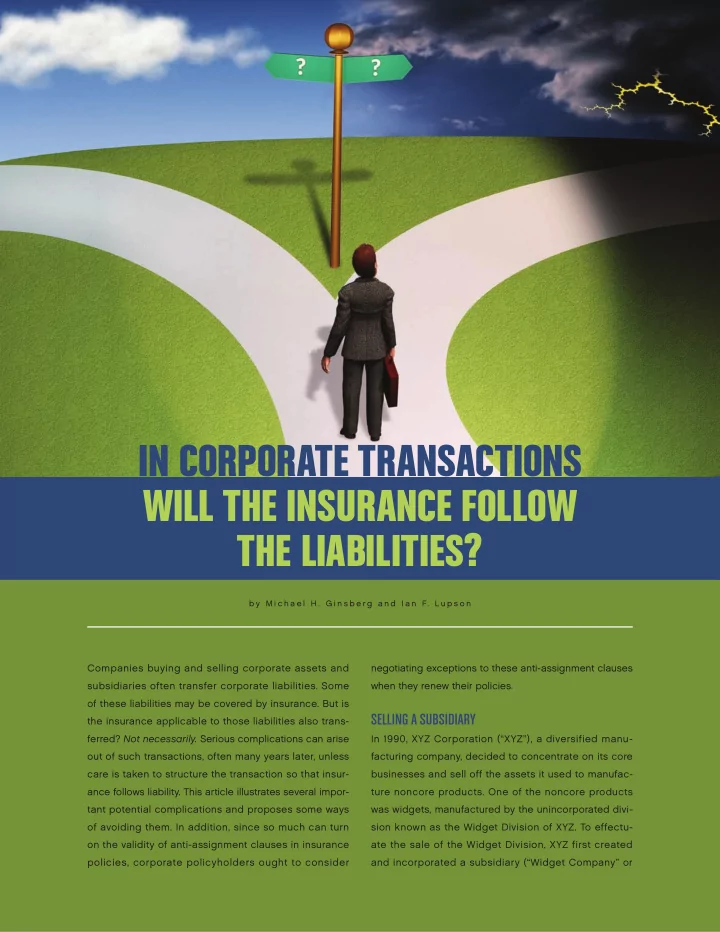

IN CORPORATE TRANSACTIONS WILL THE INSURANCE FOLLOW THE LIABILITIES? b y M i c h a e l H . G i n s b e r g a n d I a n F. L u p s o n Companies buying and selling corporate assets and negotiating exceptions to these anti-assignment clauses subsidiaries often transfer corporate liabilities. Some when they renew their policies. of these liabilities may be covered by insurance. But is SELLING A SUBSIDIARY the insurance applicable to those liabilities also trans- ferred? Not necessarily. Serious complications can arise In 1990, XYZ Corporation (“XYZ”), a diversified manu- out of such transactions, often many years later, unless facturing company, decided to concentrate on its core care is taken to structure the transaction so that insur- businesses and sell off the assets it used to manufac- ance follows liability. This article illustrates several impor- ture noncore products. One of the noncore products tant potential complications and proposes some ways was widgets, manufactured by the unincorporated divi- of avoiding them. In addition, since so much can turn sion known as the Widget Division of XYZ. To effectu- on the validity of anti-assignment clauses in insurance ate the sale of the Widget Division, XYZ first created policies, corporate policyholders ought to consider and incorporated a subsidiary (“Widget Company” or 18
“Widget”) and transferred the assets and liabilities of the consent to the assignment of the insurance policies, if any, Widget Division to Widget Company. Then, in 1995, XYZ sold to Widget Company. Widget Company to a venture capital fund. The venture fund operated Widget Company until 1998, increasing its margins Who’s right? and EBIDTA, and then sold the company to its management. As with most insurance coverage questions, the answer Fast-forward 11 years to 2009. Widget Company is now an depends on the jurisdiction whose law controls and what the independent corporate entity. It has operated successfully for documents creating and transferring Widget Company pro- the 19 years since XYZ took the assets of the Widget Division vided. For example, in the creation of Widget Company from and created Widget Company. Unfortunately, three weeks the assets of the Widget Division, did XYZ expressly transfer ago, a plaintiff filed a lawsuit against Widget Company alleg- insurance rights? If not, the insurance may not follow Widget ing that a plastic component in the company’s main product, Company’s liabilities. Even if there were an express transfer the widget, degraded over time and released vinyl chloride of insurance, would that transfer be effective, given the anti- into the atmosphere in the vicinity of the widget’s installa- assignment clause of standard form insurance policies? In tion. The plaintiff alleges that as a result of his many years of some jurisdictions the transfer is effective, but in some it is working with and around the widget, he had been exposed to not. Do the answers to these questions depend on whether vinyl chloride and is now dying of liver cancer. Upon investi- Widget Company continued its independent existence or gation, Widget discovers that vinyl chloride was in fact used was merged into a parent company? Again, the answer in a plastic component in widgets that were manufactured depends on which state’s law applies. during the time that XYZ owned the Widget Division, but that the division ceased use of vinyl chloride-containing plastic a The unavailability of insurance for the type of claim that year before Widget Company was created. Widget faces could be devastating to the company. These As with most insurance coverage questions, the answer depends on the jurisdiction whose law controls and what the documents creating and transferring the company provided. Widget Company does not dispute that XYZ’s transfer of the questions and others related to them therefore require liabilities of the Widget Division to Widget Company included careful analysis. What we know for certain is that in three the liabilities arising out of products manufactured by the states—California, Indiana, and Hawaii—insurance cover- Widget Division. Widget Company also believes, however, that age does not automatically follow the liabilities that it for- XYZ’s insurance covering the Widget Division should have merly covered, even if XYZ had expressly transferred rights to accompanied the Widget Division’s liabilities. Widget’s posi- coverage when it created Widget Company. In other words, tion is that it should therefore be entitled to insurance cov- in California, Indiana, or Hawaii, Widget Company would be erage from the insurers that covered the operations of XYZ out of luck. during the time that Widget operated as a division of XYZ. HENKEL AND ITS IMPLICATIONS Believing it has coverage, Widget tenders the claim to In Henkel Corp. v. Hartford Accident & Indemnity Co. , the those insurers for defense and, if necessary, indemnity for California Supreme Court held that where a company’s liabili- the vinyl chloride exposure claim. The insurers deny cover- ties have been transferred by contract rather than by opera- age on the ground that Widget was not their insured and tion of law (for example, in a statutory merger), the transfer that (as required by their policies) they had not given their of insurance was “defined and limited” by anti-assignment 19 19
Recommend
More recommend